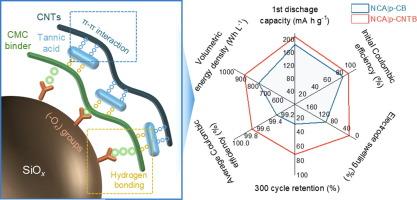提高微尺度氧化硅阳极的耐久性:通过锚定碳纳米管与羧甲基纤维素实现粘结剂网络的电机械强化
IF 13.1
1区 化学
Q1 Energy
引用次数: 0
摘要
随着锂离子电池(LIB)应用的日益普及,对高容量新一代材料的需求也随之增加。由于氧化硅具有极高的锂离子电池容量,目前被认为是一种很有前途的负极材料。然而,无论是单独使用还是与石墨材料结合使用,氧化硅在循环过程中的显著体积变化及其初始库仑效率(ICE)都使其使用复杂化。在本研究中,通过使用单宁酸作为化学交联剂对碳纳米管和羧甲基纤维素粘合剂进行化学锚定,为石墨/氧化硅混合阳极提出了一种具有高电子传导性和坚固弹性的三维导电粘合剂网络。此外,还利用氢化锂的脱氢预硫化策略来增强氧化硅的 ICE。这两种策略的结合将氧化硅的 CE 从 74% 提高到 87%,并有效缓解了其在石墨/氧化硅混合电极中的体积膨胀,从而形成了高效的电子导电粘结剂网络。因此,即使在极具挑战性的条件下,30 个循环后的容量保持率也高达 94%,容量高达 550 mA h g-1,电流密度为 4 mA cm-2。此外,为了验证在 LIB 中使用预石墨化氧化硅阳极材料和导电粘合剂网络的可行性,还使用了包含这些材料和单晶富镍阴极的完整电池。该电池在第一个循环中的放电容量增加了 27.3%(185.7 mA h g-1),并表现出 300 个循环的循环稳定性。因此,本研究为高性能锂离子电池电极的设计提供了一种简单、可行且具有洞察力的方法。本文章由计算机程序翻译,如有差异,请以英文原文为准。

Enhancing micro-scale SiOx anode durability: Electro-mechanical strengthening of binder networks via anchoring carbon nanotubes with carboxymethyl cellulose
With the increasing prevalence of lithium-ion batteries (LIBs) applications, the demand for high-capacity next-generation materials has also increased. SiOx is currently considered a promising anode material due to its exceptionally high capacity for LIBs. However, the significant volumetric changes of SiOx during cycling and its initial Coulombic efficiency (ICE) complicate its use, whether alone or in combination with graphite materials. In this study, a three-dimensional conductive binder network with high electronic conductivity and robust elasticity for graphite/SiOx blended anodes was proposed by chemically anchoring carbon nanotubes and carboxymethyl cellulose binders using tannic acid as a chemical cross-linker. In addition, a dehydrogenation-based prelithiation strategy employing lithium hydride was utilized to enhance the ICE of SiOx. The combination of these two strategies increased the CE of SiOx from 74% to 87% and effectively mitigated its volume expansion in the graphite/SiOx blended electrode, resulting in an efficient electron-conductive binder network. This led to a remarkable capacity retention of 94% after 30 cycles, even under challenging conditions, with a high capacity of 550 mA h g−1 and a current density of 4 mA cm−2. Furthermore, to validate the feasibility of utilizing prelithiated SiOx anode materials and the conductive binder network in LIBs, a full cell incorporating these materials and a single-crystalline Ni-rich cathode was used. This cell demonstrated a ∼27.3% increase in discharge capacity of the first cycle (∼185.7 mA h g−1) and exhibited a cycling stability of 300 cycles. Thus, this study reports a simple, feasible, and insightful method for designing high-performance LIB electrodes.
求助全文
通过发布文献求助,成功后即可免费获取论文全文。
去求助
来源期刊

Journal of Energy Chemistry
CHEMISTRY, APPLIED-CHEMISTRY, PHYSICAL
CiteScore
19.10
自引率
8.40%
发文量
3631
审稿时长
15 days
期刊介绍:
The Journal of Energy Chemistry, the official publication of Science Press and the Dalian Institute of Chemical Physics, Chinese Academy of Sciences, serves as a platform for reporting creative research and innovative applications in energy chemistry. It mainly reports on creative researches and innovative applications of chemical conversions of fossil energy, carbon dioxide, electrochemical energy and hydrogen energy, as well as the conversions of biomass and solar energy related with chemical issues to promote academic exchanges in the field of energy chemistry and to accelerate the exploration, research and development of energy science and technologies.
This journal focuses on original research papers covering various topics within energy chemistry worldwide, including:
Optimized utilization of fossil energy
Hydrogen energy
Conversion and storage of electrochemical energy
Capture, storage, and chemical conversion of carbon dioxide
Materials and nanotechnologies for energy conversion and storage
Chemistry in biomass conversion
Chemistry in the utilization of solar energy
 求助内容:
求助内容: 应助结果提醒方式:
应助结果提醒方式:


